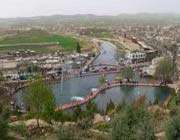The city of Saraab in East Azarbaijan Province

The city of Saraab is situated in East Azarbaijan Province and is engulfed by Sabalan Mountain Range and Bozqoush Mountain Range from the north, east, and south. Hence, this city is in fact an engulfed plain, which is only accessible through the west.
Given this city's geographical situation, it maintains a chilly climate in winter and a mild climate during the summer season. It maintains a high rainfall and its surrounding altitudes are blanketed with snow. The rivers, originating from "Sabalan" confluence in southern region of the city of "Saraab" forming "Aji Chaai" River.
The enriched meadows of this region provide an appropriate site for the nomads of this province. Hence, Saraab region is considered as one of the most important animal husbandry centers in Iran. The local cows of this region are exemplary across the country in regard to their compatibility with the living environment, resistance against illnesses, and longevity.
The city of Saraab links different cities of East Azarbaijan Province and a number of cities in neighboring provinces, to each other. This route has also been of paramount importance in the past and was a hub of commercial convoys. During the reign of Mongols over Iran, the city of Saraab was one of the main centers of the Mongols regime in Azarbaijan region. In the early days of the rule of Safavid Dynasty throughout which the cities of Tabriz and Ardebil were considered as two of the important cities of Iran, the city of Saraab was also of paramount importance due to its proximity to these two cities. The war between the Safavid King Shah Ismail and the commander of Ottomans' troops, Khalil Pasha, took place in the city of Saraab.
The city of Saraab is also one of Iran's historical cities. The historical monuments remaining from the era of "Oratoha", who lived in 7th and 8th Century BC, prove the historical nature of this city. Many tourists and geographers have also focused on this city in their travel books. For example, the Iranian historian and geographer, Hamdollah Mostofi, in his book: "Nazhet al-Qoloub" which was compiled in 740 AH, has noted: "The city of Saraab maintains a cold climate and its needed water is provided from the river that runs through it. Its products include grains."
The Arab tourist, Ebn-e Houqal, who lived in 10th Century AD, has described the city of Saraab as follows: "Saraab is a beautiful city, which is home to several mills, grain farms, and orchards, while maintaining several appropriate motels and markets."
Unfortunately, this city was severely harmed amid the attack of Mongols in 1220 AD and the mass murders committed by the Mongols ruined the prosperity of this city. The historical monuments that remain in this city prove that Saraab is an ancient city.
Two kilometers north of the city of Saraab, there is "Qale Jouq" hill, which has been named after a castle which was previously built over this hill. The sun-dried mud bricks of this castle remain to this day. Throughout the excavations that took place in this hill, 5-meter tall walls were unearthed. Based on the studies that were conducted on these walls' bricks, it was disclosed that they belonged to 7th and 8th Centuries BC. In addition to these sun-dried mud bricks, different types of porcelain belonging to 2000 BC were unearthed in this hill.
Among the historical sites of the city of Saraab, the Jaa'meh Mosque is also of major significance. It belongs to 15th Century AD. Unlike the majority of Iranian mosques, it doesn't have a minaret. However, it maintains a large roofed section with three altars. The roofed region of this mosque has sixty domes, which have been built over pillars, creating a beautiful scene. Over the eastern gateway of this mosque, a marble-made inscription belonging to 15th Century AD is observed. This mosque was registered among Iran's national works in March 1968.
In addition to historical monuments and sites, the museum on nomadic lifestyle is considered as one of the tourist attraction sites of this city. This museum intends to familiarize the visitors with the beauties and difficulties of nomadic lifestyle and the achievements of the Iranian nomads in different domains throughout the past millenniums.
The nomadic lifestyle maintains a long history across Iran and Azarbaijan Province; and nomads maintain a crucial role in the political and social history of this land. Many of the pre- and post-Islamic era governments and ruling system originated from the nomads.
Meanwhile, the nomadic lifestyle is declining in Iran, including Azarbaijan Province. Hence, the museum of nomads in Azarbaijan region is considered to be a historical necessity.
Note that the city of Saraab maintains a special status, given that it is en route Tabriz-Ardebil-Gilan Province route, and every year thousands of tourists pass through this city.
The museum on nomadic lifestyle is one of the museums of anthropology, which displays cultural, traditional, and ethnical features of this region of Iran and presents the popular cultural, economic, and social values. In this museum, the outcomes of studies conducted on beliefs, traditions, language, livelihood, accommodation, arts and techniques, food, clothing, and handicrafts of nomads, are presented to the enthusiasts.
The stalls of this museum describe the bitter and sweet features of nomadic lifestyle. This museum consists of different sections which make the visitors familiar with the achievements of the nomads of this province in different economic, cultural, and political scenes, in the past millenniums.
Source: irib.ir
Other links:
Interesting places of East Azarbayjan
Do you know Tabriz city?
Monuments in Tabriz